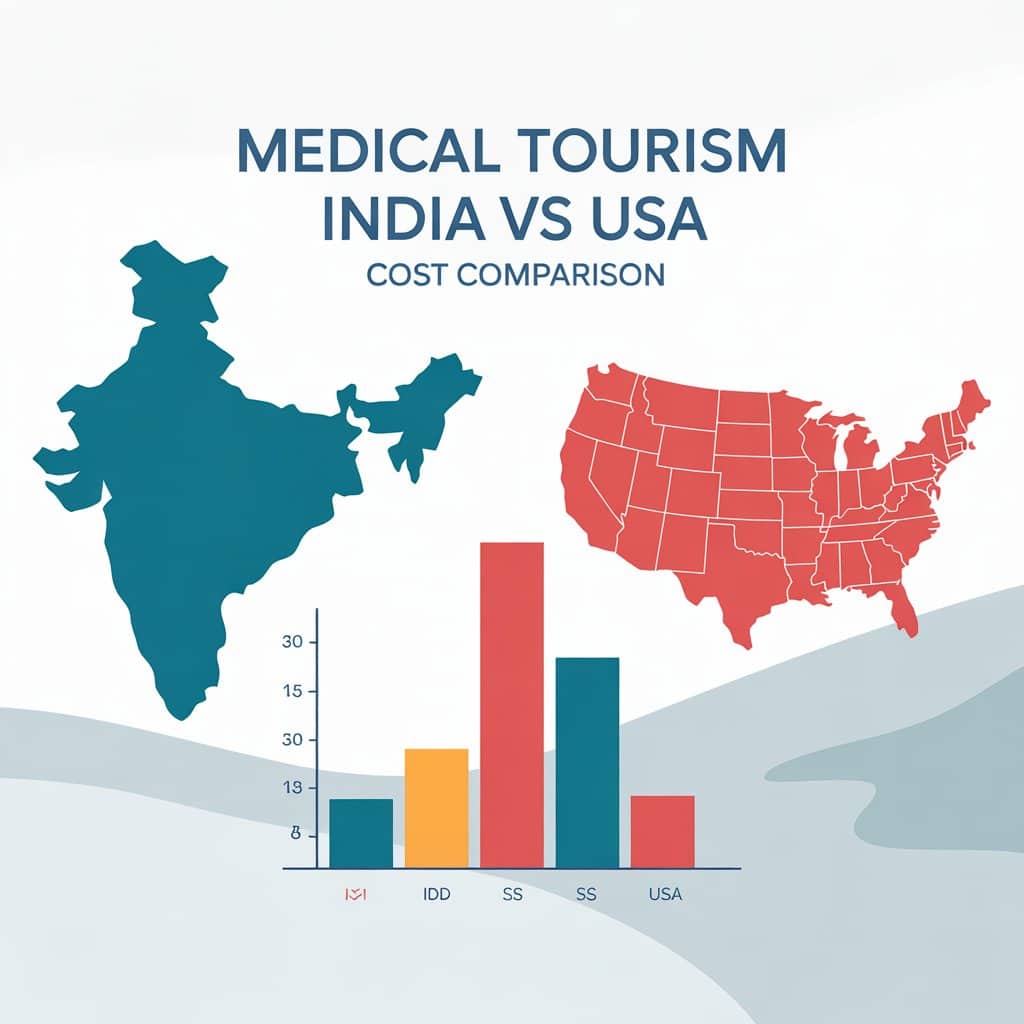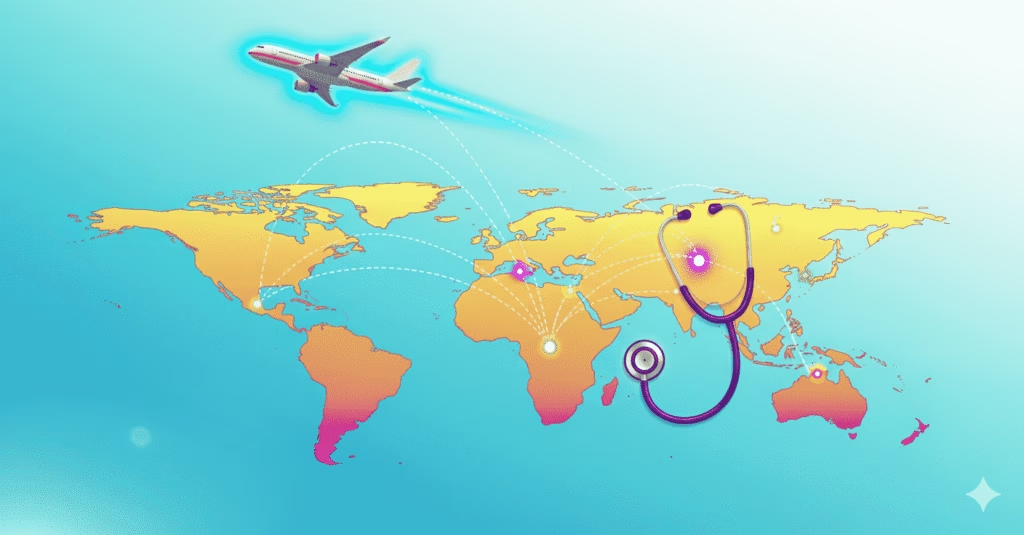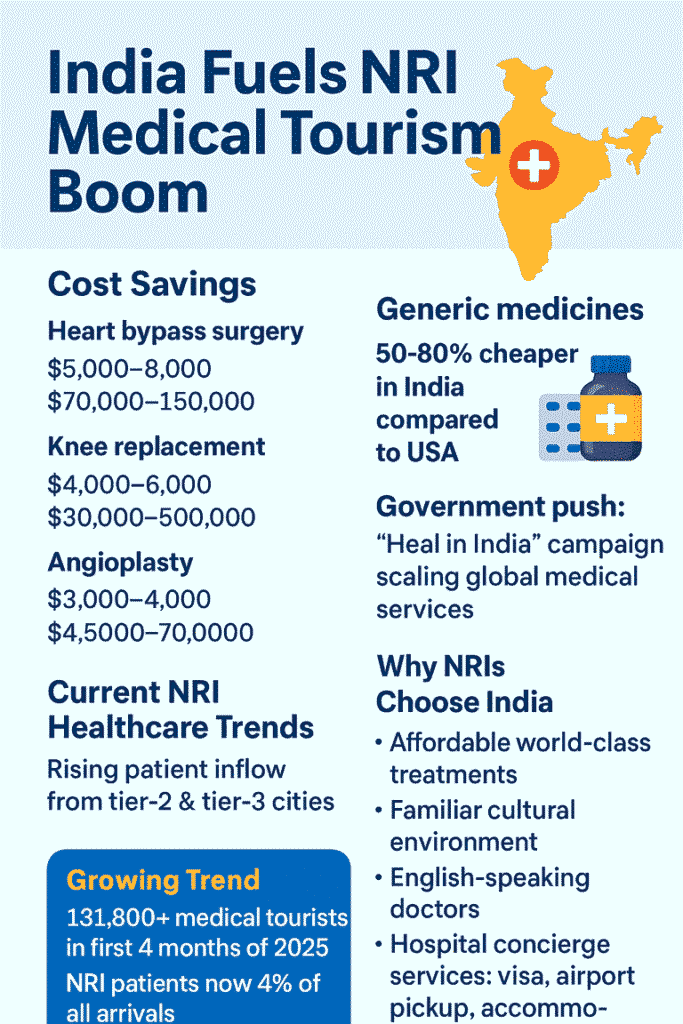Introduction
Medical tourism in India is rapidly growing, attracting patients from the US, Europe, Africa, and the Middle East. A major factor driving this growth in the medical tourism is cost comparison advantage, where patients save between 60–80% compared to Western countries. Whether it’s a medical vacation in India combining treatment with holistic wellness, or simply accessing affordable healthcare, international patients are finding tremendous value.
India’s ability to offer world-class hospitals, internationally trained doctors, and transparent medical tourism prices makes it a global hub. With the government’s Heal in India initiative, the country is not just affordable but also highly reliable for quality care.
Healthcare Cost Landscape in India vs USA
When analyzing medical tourism prices, the gap between India and the USA is significant. In the United States, patients face high insurance premiums and lengthy waits. In India, streamlined processes, lower labor costs, and affordable pharmaceuticals allow hospitals to charge far less without compromising on quality.
For example, a heart bypass surgery in the USA costs $120,000–150,000, while in India it is $7,000–10,000. Similarly, hip replacement surgery costs around $40,000–60,000 in the USA, but only $6,000–8,000 in India. Such dramatic differences make India one of the most cost-effective destinations for medical travelers seeking a balance of affordability and quality.
Procedure Cost Comparison Table
Medical Tourism Prices: India vs USA
| Medical Procedure | Average Cost in USA | Average Cost in India | Savings % |
|---|---|---|---|
| Heart Bypass Surgery | $120,000–150,000 | $7,000–10,000 | 80–85% |
| Hip Replacement | $40,000–60,000 | $6,000–8,000 | 75–80% |
| Knee Replacement | $35,000–50,000 | $5,000–7,000 | 80–85% |
| Dental Implants | $3,000–6,000 | $600–1,000 | 70–80% |
| Cosmetic Surgery (Rhinoplasty) | $10,000–15,000 | $2,000–3,000 | 70–80% |
Disclaimer:
The costs listed above are average estimates for comparison purposes only. Actual medical tourism prices may vary depending on the hospital, doctor’s expertise, patient’s condition, room category, city, and post-operative care requirements. Patients are strongly advised to:
- Confirm the latest prices directly with the hospital or medical facilitator.
- Check what is included in the package (e.g., medicines, stay, diagnostics, follow-up).
- Factor in additional expenses such as visa, flights, accommodation, and post-treatment recovery.
This information is not a substitute for professional medical advice. Always consult your doctor and chosen hospital before making any medical travel decisions.
Factors Influencing Cost Differences
Lower Labor and Pharmaceutical Costs
India’s ability to provide affordable treatment lies in reduced labor and pharmaceutical expenses. Skilled surgeons and staff deliver high-quality care while keeping costs low. India’s strong generic drug industry also lowers treatment costs compared to the USA.
Patients visiting for a medical vacation in India often report surprise at the affordability of complex surgeries when compared to global medical tourism prices. This blend of affordability and advanced treatment is one of India’s strongest selling points.
Hospital Infrastructure and Government Policies
India’s hospitals, such as Apollo, Fortis, and Medanta, rival Western facilities. With JCI and NABH accreditations, they meet international standards of care. Policies like Heal in India further enhance patient trust by simplifying medical visas and promoting India globally as a medical tourism hub.
Transparent medical tourism prices and package-based billing ensure international patients know exactly what they will pay, making India far more predictable compared to US hospitals with hidden costs.
Waiting Times and Appointment Availability
US patients often wait weeks or months for elective surgeries. In contrast, India provides quick access, with international patients often receiving same-week appointments.
This not only shortens recovery timelines but also allows patients to combine treatment with a Holistic experience as a part of medical vacation in India. Many patients recover in wellness resorts or Ayurveda retreats, blending modern medicine with traditional therapies for a more holistic approach.
Quality, Accreditation & Safety
Accreditation and Global Recognition
India boasts more than 60+ JCI-accredited hospitals and hundreds of NABH-certified institutions, ensuring global standards of safety and treatment quality. Many doctors are trained abroad, further boosting patient confidence.
Language barriers are minimal, as English is widely spoken in hospitals and by medical staff. Dedicated international patient departments also manage logistics for overseas visitors, making India a seamless choice for medical travelers.
Technology Adoption and Patient Safety
Advanced medical technology such as robotic surgery, 3D orthopedics, and advanced cancer treatments are available in Indian hospitals. Despite lower medical tourism prices, patients benefit from cutting-edge facilities that rival Western centers.
Hospitals also emphasize infection control, multilingual nursing support, and post-surgery teleconsultations, ensuring patient safety throughout the journey.
Additional Benefits for International Patients
Travel Logistics and Medical Visas
India offers streamlined e-Medical visas with fast approval. Hospitals often assist in the visa process, ensuring hassle-free travel. Affordable accommodation and direct air connections make India even more accessible for medical travelers.
This convenience has made medical tourism India packages increasingly popular, with many hospitals collaborating with travel agencies to offer combined healthcare and tourism deals.
Post-treatment Wellness and Recovery Options
Recovery is as important as surgery itself. Opting for a medical vacation in India allow patients to recover in wellness retreats, yoga centers, or Ayurveda resorts. These options not only speed up healing but also promote mental and emotional well-being.
The integration of modern surgery and traditional wellness creates a unique advantage for India compared to other countries with higher medical tourism prices but limited holistic care options.
Considerations & Caveats
Importance of Research and Accredited Hospitals
Patients should prioritize JCI- or NABH-accredited hospitals to ensure high-quality care. While India is affordable, quality varies, so careful hospital selection is crucial.
Follow-up care in one’s home country should also be factored into planning. Patients are encouraged to coordinate post-treatment with both Indian doctors and local healthcare providers.
FAQs on Medical Tourism in India
Conclusion
The medical tourism cost comparison clearly highlights India’s competitive advantage over the USA. Patients benefit not only from lower medical tourism prices but also from shorter wait times, advanced hospitals, and holistic recovery options.
Whether seeking heart surgery, orthopedic treatment, or a medical vacation in India to Holistic Wellness retreats or Yoga centres, international patients find India to be the perfect balance of affordability, quality, and cultural richness. With government initiatives and continued investment, India is set to strengthen its position as a top global destination for medical tourism in 2025 and beyond.




